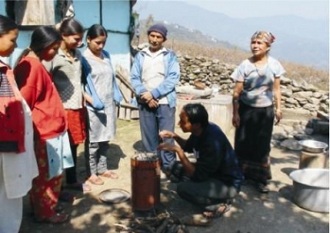David Pennise, Simone Brant, Seth Mahu Agbeve, Wilhemina Quaye, Firehiwot Mengesha, Wubshet Tadele, Todd Wofchuck,
Indoor air quality impacts of an improved wood stove in Ghana and an ethanol stove in Ethiopia, IN: Energy for Sustainable Development, In Press, Corrected Proof, Available online 24 May 2009, ISSN 0973-0826, DOI: 10.1016/j.esd.2009.04.003.
This study was undertaken to assess the potential of two types of improved cookstoves to reduce indoor air pollution in African homes. An ethanol stove, the CleanCook, was tested in three locations in Ethiopia: the city of Addis Ababa and the Bonga and Kebribeyah Refugee Camps, while a wood-burning rocket stove, the Gyapa, was evaluated in Accra, Ghana.
In both countries, kitchen concentrations of PM2.5 and CO, the two pollutants responsible for the bulk of the ill-health associated with indoor smoke, were monitored in a before and after study design without controls. Baseline (`before’) measurements were made in households using a traditional stove or open fire. `After’ measurements were performed in the same households, once the improved stove had been introduced. PM2.5 was measured using UCB Particle Monitors, which have photoelectric detectors. CO was measured with Onset HOBO Loggers. In Ghana and Kebribeyah Camp, CO was also measured with Gastec diffusion tubes.
In Ghana, average 24-hour PM2.5 concentrations decreased 52% from 650 [mu]g/m3 in the ‘before’ phase to 320 [mu]g/m3 in the ‘after’ phase (p = 0.00), and average 24-hour kitchen CO concentrations decreased 40% from 12.3 ppm to 7.4 ppm (p = 0.01). Including all three subgroups in Ethiopia, average PM2.5 concentrations decreased 84% from 1 250 [mu]g/m3 to 200 [mu]g/m3 (p = 0.00) and average CO concentrations decreased 76% from 38.9 ppm to 9.2 ppm (p = 0.00). 24-hour average CO levels in households using both the Gyapa and CleanCook stoves met, or nearly met, the World Health Organization (WHO) 8-hour Air Quality Guideline. PM2.5 concentrations were well above both the WHO 24-hour Guideline and Interim Targets.
Therefore, despite the significant improvements associated with both of these stoves, further changes in stove or fuel type or household fuel mixing patterns would be required to bring PM to levels that are not considered harmful to health.



